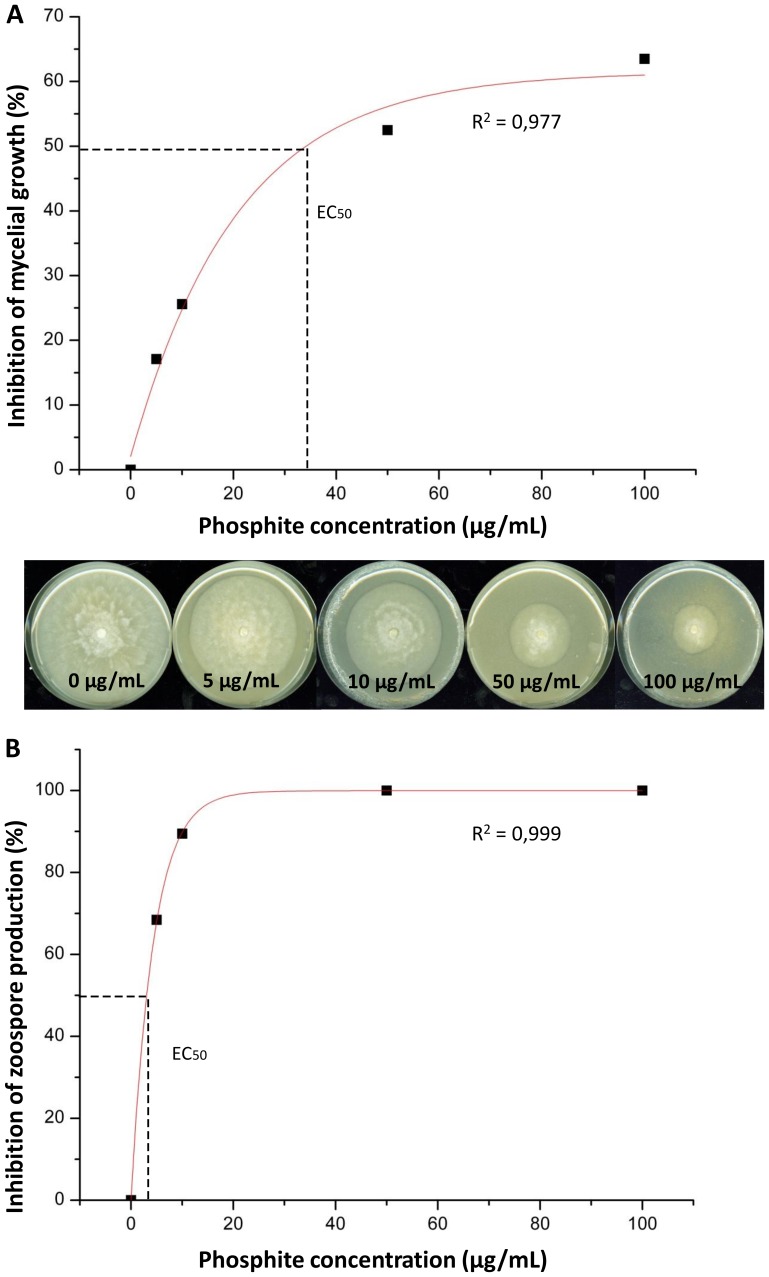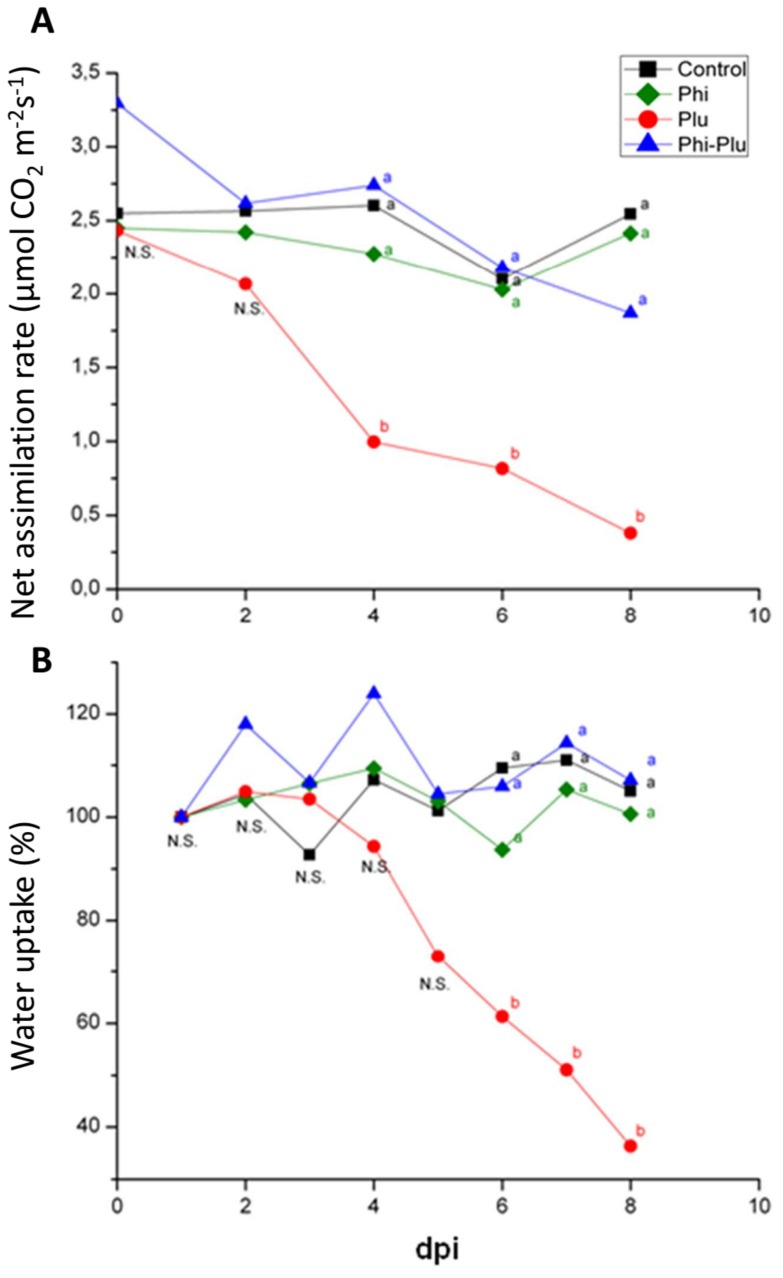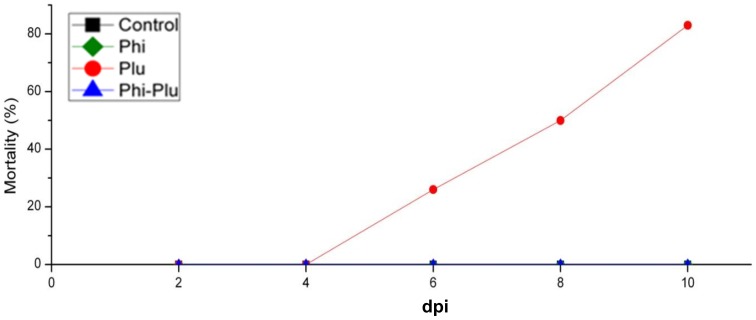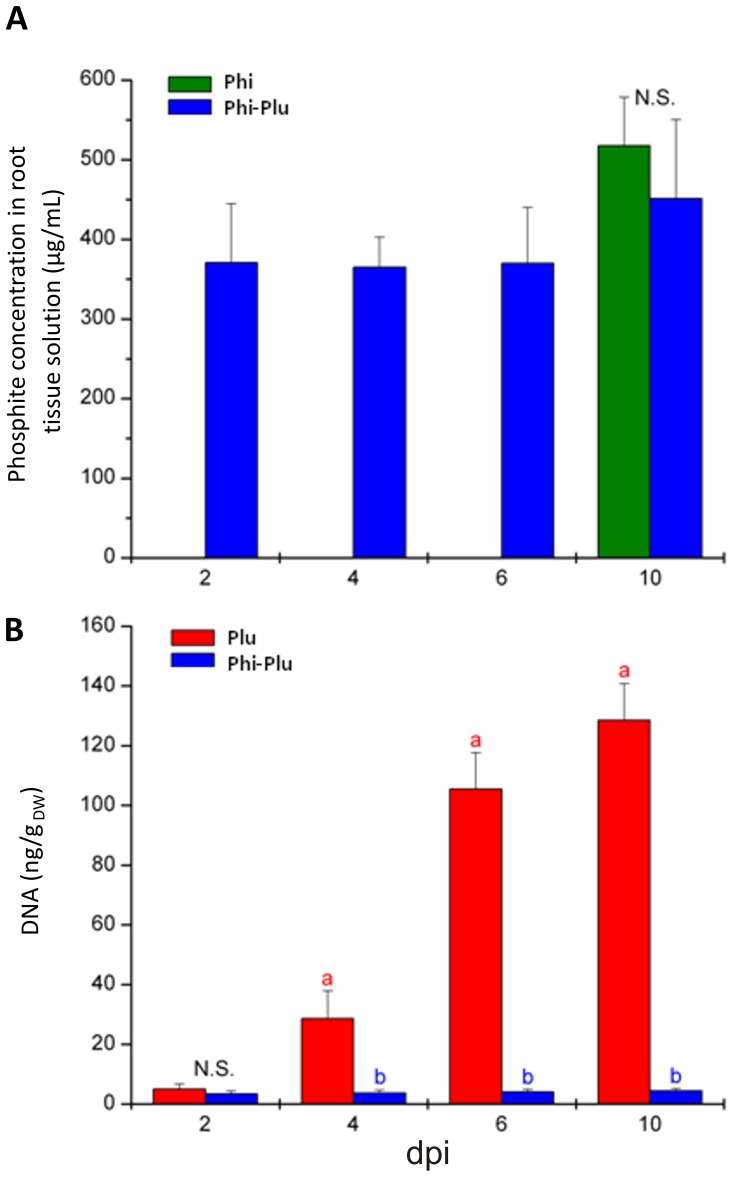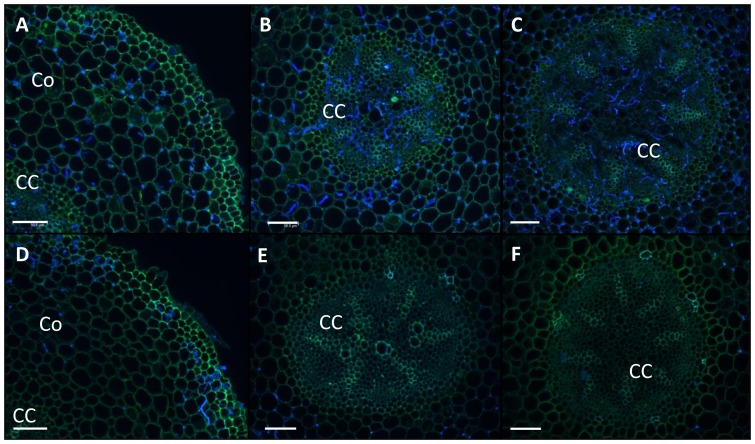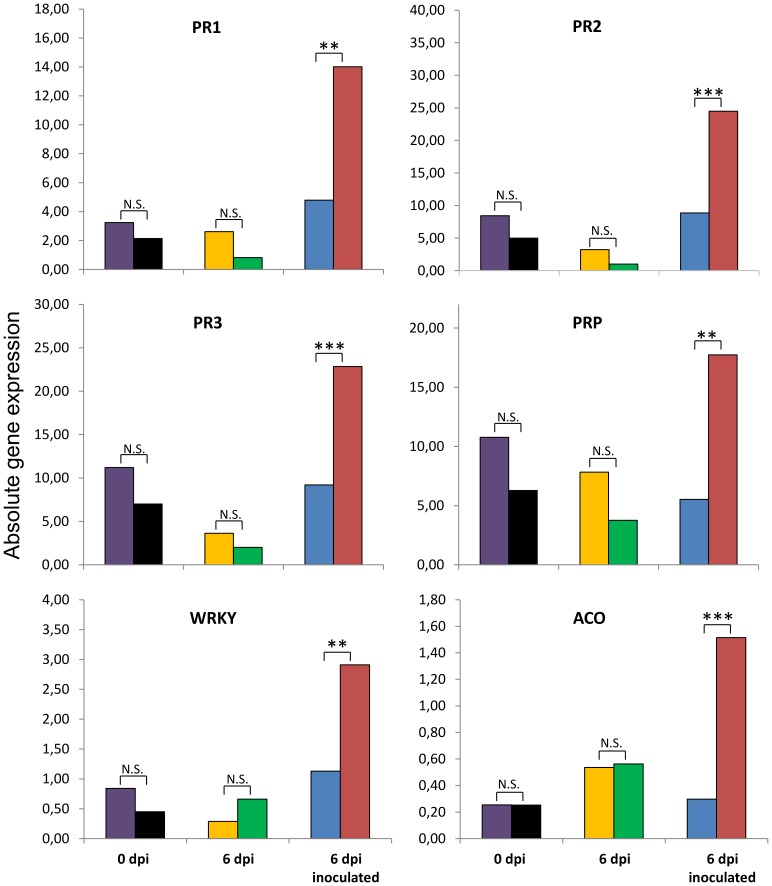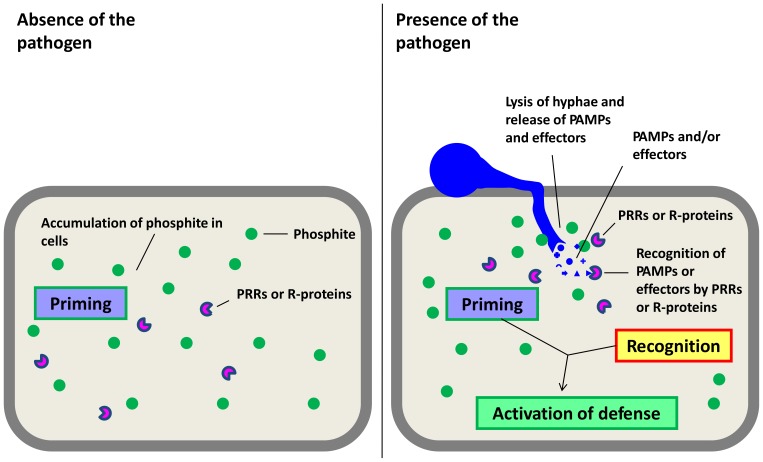Abstract
Phytophthora plurivora causes severe damage on Fagus sylvatica and is responsible for the extensive decline of European Beech throughout Europe. Unfortunately, no effective treatment against this disease is available. Phosphite (Phi) is known to protect plants against Phytophthora species; however, its mode of action towards P. plurivora is still unknown. To discover the effect of Phi on root infection, leaves were sprayed with Phi and roots were subsequently inoculated with P. plurivora zoospores. Seedling physiology, defense responses, colonization of root tissue by the pathogen and mortality were monitored. Additionally the Phi concentration in roots was quantified. Finally, the effect of Phi on mycelial growth and zoospore formation was recorded. Phi treatment was remarkably efficient in protecting beech against P. plurivora; all Phi treated plants survived infection. Phi treated and infected seedlings showed a strong up-regulation of several defense genes in jasmonate, salicylic acid and ethylene pathways. Moreover, all physiological parameters measured were comparable to control plants. The local Phi concentration detected in roots was high enough to inhibit pathogen growth. Phi treatment alone did not harm seedling physiology or induce defense responses. The up-regulation of defense genes could be explained either by priming or by facilitation of pathogen recognition of the host.
Introduction
Protecting plants from Phytophthora species is still a challenge. In the last decade a large number of new species have been described beyond agriculture which are known to cause enormous economic and environmental losses [1], thus driving the attention of the scientific community towards the genus Phytophthora [2].
Phytophthora plurivora is a hemibiotrophic root pathogen with worldwide distribution, attacking several plant species, in particular, Fagus sylvatica (European beech) [3], [4]. F. sylvatica is a dominant species in most of the European forests, with great economic value. The decline of F. sylvatica in European forests was associated with the interaction with P. plurivora (formerly called P. citricola) and climatic extremes [5].
During evolution plants have developed defense mechanisms that enable them to recognize invaders and to avoid colonization by most pathogenic microorganisms [6]. Thus resistance is the rule and susceptibility the exception. The defense mechanisms in plants consist of a two-layered immune-system [7]. The first layer depends on recognition of PAMPs (pathogen associated molecular patterns) by pattern-recognition receptors (PRRs) localized at plasma membrane structures, resulting in PAMP triggered immunity (PTI). Pathogens try to circumvent plant PTI and therefore evolved effectors to suppress PAMP-triggered defense that leads to effector triggered susceptibility (ETS). In order to defend itself against these pathogen-derived effectors, plants have developed specific receptor (R) proteins as the second layer of defense. These R-proteins recognize effector proteins of the invader directly or indirectly leading to effector triggered immunity (ETI) [8]. However, successful pathogens, including Phytophthora species, have the ability to subvert these defense mechanisms either by avoiding their recognition or by reprogramming host metabolism [9], [10]. The P. plurivora - F. sylvatica interaction is characterized by a “striking lack of defense gene induction” and it was concluded that P. plurivora possibly escapes the main plant-recognition systems [11]. Thus, supporting the recognition of the invader by the host might be a key-factor in managing Phytophthora diseases.
Plant recognition of invaders commonly causes a fast flux of ions, the accumulation of reactive oxygen species (ROS), the activation of MAP kinases signaling cascades as well as specific gene expression and finally the activation of defense pathways [12]. Induced downstream responses rely in most cases on a network of cross-communication between signaling pathways mediated by salicylic acid (SA), jasmonate (JA) or ethylene (ET) [13].
Unfortunately, Phytophthora pathogens cannot be controlled with well-known fungicides, because as Oomycetes they do not synthesize chitin and ergosterol. However, many investigations have shown that different salts of the phosphorous acid, the phosphites, are effective in the control of Phytophthora pathogens. Bark injection of phosphite successfully controlled sudden oak death of coast life oaks caused by P. ramorum [14]. It was also proved that phosphite treatment of Arabidopsis thaliana leaves triggered the release of superoxide, caused localized cell death and enhanced accumulation of phenolics around infected cells [15]. In consequence growth of P. palmivora was restricted and the production of sporangia was inhibited. In the presence of the superoxide quencher Mn(II)-desferal, there was no longer hypersensitive cell death and the pathogen was able to grow in phosphite-treated plants. These data prove that inhibition of the pathogen was due to superoxide release rather than a direct effect of the chemical. Phosphite treatment was recently shown to prime Arabidopsis thaliana for defense responses of the salicylic acid (SA) and jasmonic acid/ethylene (JA/ET) pathways [16]. Thus, phosphite treated plants showed a significant reduction in lesion size after infection with P. cinnamomi.
Besides interfering with defense pathways of host plants, phosphite was shown to interact directly with Phytophthora pathogens. The chemical caused hyphal distortion and lyses of cell walls in parallel with a down-regulation of many genes encoding proteins involved in cell wall synthesis and cytoskeleton functioning [17]. It was also demonstrated that oospore production, sporangia formation and mycelial growth of P. cinnamomi and P. citricola were significantly inhibited by either phosphorous acid or fosetyl-Al [18]. It was concluded that phosphite acts in a dual way: when phosphite concentrations are low, the chemical induced host defense enzymes such as 4-coumarate coenzyme A ligase (4-CL) and cinnamyl alcohol dehydrogenase (CAD). However, at high phosphite concentrations, the chemical acted directly on P. cinnamomi and inhibited its growth [19].
Extensive field studies have proved that phosphite treatment of Eucalyptus and Banksia species is a practical option to control P. cinnamomi root infection over several years [20] [21]. However, glasshouse studies showed that phosphite treatment reduced but did not prevent the production of viable zoospores on infected trees [22]. Thus, the authors concluded that phosphite application will lower the amount of infection by Phytophthora species, but may not remove the risk of Phytophthora spreading from already infected trees.
The aim of this study was to elucidate the mechanisms of potassium phosphite on plant physiology and gene regulation of treated beech saplings in order to understand the protective effect of this chemical on the highly susceptible interaction between F. sylvatica and P. plurivora.
Results
In vitro inhibition of mycelial growth and zoospore inhibition of P. plurivora by phosphite
Inhibition of mycelial growth started at 5 µg/mL and reached 65% inhibition with 100 µg/mL of phosphite (Figure 1a and 1b). The EC50 value was calculated as 34 µg/mL. The number of zoospores released was significantly lower for all phosphite treatments (Figure 1c). The EC50 value for zoospore inhibition was determined as 2.9 µg/mL, about ten times lower than the inhibition of mycelial growth.
Figure 1. Effect of phosphite on in vitro growth and zoospore production of P. plurivora.
(a) Inhibition of P. plurivora mycelial growth using different phosphite concentrations. (b) P. plurivora cultures in Petri dishes illustrating the inhibition of mycelial radial growth with increasing phosphite concentrations. The mycelial colonies were six days old. (c) Inhibition of P. plurivora zoospore production at different phosphite concentrations. EC50 shows the concentration that inhibits growth or zoospore production to 50%. Trend-lines were fitted using a logarithmic function. These assays were repeated three times showing similar results. n = 5 for each assay.
Physiological plant responses to phosphite treatment and infection
Phosphite treatment did not show any beneficial or adverse effect on physiological parameters of not-inoculated plants. No significant differences were found for net CO2 assimilation, water uptake, Jmax or Vcmax in comparison with control plants (Figure 2 a, b, and Table 1).
Figure 2. Effect of phosphite treatment and P. plurivora infection on net CO2 assimilation rates (µmol CO2 m−2s−1) (a) and water uptake (b) over ten days.
Water uptake was calculated as percent of g/cm2 leaf surface of four months-old beech saplings. Treatments: Control: not infected and not phosphite treated plants; Phi: phosphite treatment; Plu: roots inoculated with zoospores of P. plurivora; Phi-Plu: foliar application of 0.5% phosphite on plants prior to inoculation with zoospores of P. plurivora. The experiment was repeated three times showing similar results. N = 6 plants per treatment. dpi- days post inoculation. Different letters at the same time points show statistical differences (P≤0.05), N.S. = Not-significant.
Table 1. Rubisco activity (Vcmax) and maximum rate of electron transport (Jmax) data fitted from A/ci curves of F. sylvatica seedlings at 8 days post inoculation.
| A/ci curves fitted parameters | ||
| Treatment | Vcmax [µmol CO2 m−2s−1] | Jmax [µmol e− m−2s−1] |
| Control | 12.17 a* | 24.10 a |
| Phi | 10.22 a | 19.46 ab |
| Plu | 4.99 b | 19.46 ab |
| Phi-Plu | 10.42 a | 26.01 a |
Same letters within a column represent no statistical differences, Tukey test (P≤0,05).
However, P. plurivora infection strongly affected plant physiology of not phosphite –treated saplings. CO2 assimilation rates and water uptake strongly decreased during the experiment, reaching almost zero values at 10 dpi (Figure 2 a, b). VcMax and Jmax were also affected, showing significantly lower values as compared to control plants (Table 1).
Phosphite treatment converted the susceptible interaction between F. sylvatica and P. plurivora into a resistant one. All physiological parameters analyzed did not differ to control plants (Figure 2a, b; and Table 1).
Symptoms and mortality of plants
No symptoms or mortality were recorded for not-inoculated control plants and those treated with phosphite (Figure 3). Wilting symptoms were recorded for inoculated plants after 4 dpi. At the end of the experiment, 83% of the infected plants had died. Plants treated with Phi and inoculated with P. plurivora showed no symptoms and no mortality during the whole experiment (Figure 3).
Figure 3. Effect of phosphite treatment and P. plurivora infection on plant mortality over time.
Treatments: Con (black square): not phosphite treated and not inoculated control plants; Phi (green square): plants sprayed with phosphite (0.5%) on leaves until run off; Plu (red circle): roots infected with P. plurivora; Phi-Plu (blue triangle): plants sprayed with phosphite (0.5%) on leaves until run off four days prior to infection with P. plurivora. n = 6 plants per treatment. The experiment was repeated three times showing similar results. dpi: days post inoculation.
Quantification of phosphite and P. plurivora in roots
The concentration of phosphite in infected roots ranged from 370 to 510 µg/mL during the experiment (Figure 4a). These concentrations are about ten times higher than those necessary to inhibit mycelial growth of P. plurivora to 50% (compare Figure 1a and 4a). Similar phosphite concentrations were recorded for P. plurivora inoculated and not inoculated plants. No phosphite was detected in roots of control plants.
Figure 4. Concentrations of phosphite and P. plurivora DNA along time.
(a) Phosphite concentrations of root tissue. (b) qPCR analysis of P. plurivora DNA along time (ng/gDW). Red bars: Plants infected with P. plurivora; blue bars: Plants infected with P. plurivora and treated with phosphite (0.5%). Green bars: Plants treated with Phi. n = 6 plants per treatment. The experiments were repeated 3 times showing similar results. Dpi: days post inoculation. Different letters at the same time points show statistical differences (P≤0.05), N.S. = Not-significant.
The P. plurivora DNA contents of infected plants increased steadily throughout the experiment and reached the highest values after ten days (Figure 4b). However, the corresponding DNA values of roots of phosphite treated and infected plants were much lower, indicating the powerful action of this compound to protect beech from P. plurivora. No DNA of P. plurivora was recorded in control and phosphite-treated not-inoculated plants (data not shown).
P. plurivora colonization of plant tissue with or without phosphite treatment
Two days after infection (dpi) mycelia of the pathogen were already visible throughout the whole cortex tissue (Figure 5a). Four dpi the pathogen had reached the central cylinder and 10 dpi the phloem tissue as well as the pith was severely destroyed by P. plurivora (Figure 5b and c). In contrast, in beech plants treated with phosphite, P. plurivora mycelia were only visualized in the outer cortex tissue after 2 dpi. However, no mycelia were detected in the central cylinder and the pith even not after 10 dpi at the end of the experiment (Figure 5d to f).
Figure 5. Effect of phosphite treatment on P. plurivora colonization of roots.
Confocal laser scanning microscopy images of cross-sections of beech sapling roots infected with P. plurivora and either treated or not treated with phosphite after 2, 4 and 10 dpi (A, B, C). Beech sapling roots infected with P. plurivora and treated with phosphite (0.5%) after 2, 4 and 10 dpi (D, E, F). (Co) cortex, (CC) central cylinder, White bars represent 50 µm.
Expression of defense genes of beech plants treated with or without phosphite and infected with P. plurivora
Phosphite treatment did not affect gene expression in beech roots as compared to control plants, neither at time 0 nor at a 6 dpi (purple and black; yellow and green bars, respectively) (Figure 6). Likewise, no statistically significant differences were found when control plants were compared with infected ones at 6 dpi (yellow and blue bars). However, a strong up-regulation for all genes analyzed was measured in plants treated with phosphite and infected with the pathogen at this time point.
Figure 6. Effect of phosphite treatment and P. plurivora infection on the expression of defense-related genes.
Absolute gene expression for PR1, PR2, PRP and WRKY (SA signaling pathway) as well as for PR3 and ACO (JA/ET signaling pathway) of beech saplings for all treatments. Purple and yellow bars represent control plants at time zero and after six days. Black and green bars represent phosphite treated plants at time zero and after six days. Blue bars represent infected plants at 6 dpi. Red bars represent phosphite-treated and infected plants at time 6 dpi. Asterisks show level of significance (P≤0.05*; P≤0.01**; P≤0.001***); N.S. Not-significant; n = 4. The experiment was repeated three times showing similar results.
Discussion
In this study, the effects of Phi on beech plants, as well as the ability of the chemical to protect the host towards root infection by the highly aggressive pathogen P. plurivora were analyzed. In vitro assays proved that mycelial growth was inhibited in a dose-dependent manner and the EC50 value was calculated as 34 µg/ml of Phi. Surprisingly, growth of P. plurivora was not inhibited totally, even at the highest Phi concentrations, possibly indicating that the P. plurivora isolate was able to detoxify phosphite to a certain amount. Similar results were also reported showing that some P. cinnamomi isolates were less sensitive to phosphite than others [23]. The authors concluded that sensitivity to Phi may vary within species or even within isolates. Besides affecting mycelia growth, Phi had also an effect on zoospores. Less than 5 µg/ml of Phi was sufficient to stop zoospores production to 50 per cent. Similar EC-values were also calculated for the effect of phosphorous acid, fosetyl-Al, fosetyl-Ca as well as fosetyl-Na on sporangia formation and zoospore release of P. cinnamomi and P. citricola [18].
It was proved that spraying leaves with 0.5% Phi, four days before roots were challenged with P. plurivora zoospores, was sufficient to convert the highly susceptible interaction between beech and P. plurivora into a resistant one. No mortality of any seedlings was recorded after 10 days of infection at the end of the experiment. This is in good agreement with the qPCR data for root infection and the laser scanning microscopy images showing the spread of P. plurivora in root tissue. Both data sets revealed only a very weak colonization of roots by the pathogen in Phi treated plants as compared to not-treated infected saplings. This strong protective effect of Phi on infected plants could be explained by its concentration in root tissue which was calculated to be about ten times higher than the EC50 value. It was also suggested that the degree of resistance of Phi treated host plants correlates with its concentration within plant tissue and that basically the exposure of hyphae to Phi stops the spread of the pathogen [17]. The reason why the Phi concentrations were expressed as µg/ml and not as µg/gDW, as often reported was to make it possible to compare the concentrations of root tissue directly with data calculated for the in vitro experiments mentioned above. The Phi data of roots also implicated that the chemical was transported rapidly from leaves into roots. By six days after foliar application the Phi concentrations were as high as at the end of the experiment. These data agree with previous publications showing that Phi was freely translocated in association with photoassimilates throughout the plant in a source-sink relationship and that it accumulated mainly in cell vacuoles [19], [24], [25].
The Phi concentration used in the experiments (0.5%) to induce resistance did not impair physiological parameters of beech saplings, such as net assimilation rate, Jmax, VcMax and water uptake. However, some phytotoxicity was reported for Eucalyptus marginata plants when treated with Phi in the rage of 0.25 to 1% [26]. The Phi phytotoxicity may vary within plant species.
Besides local toxicity, restriction of growth of P. plurivora could also be explained by direct or indirect stimulation of plant defense responses by Phi. Up to now, the molecular mechanisms underlying Phi-activation of SA or JA/ET signaling pathways are poorly understood. In order to shed light on this, the expression of defense-related genes, which are used as markers for “SA” and “JA/ET” defense pathways, were examined. It was shown by Conrath et al. (2002) that up-regulation of defense genes, independent of the signaling pathway, can often be explained by priming. In our experiments, gene up-regulation was only recorded for plants treated with Phi and inoculated with P. plurivora, whereas there was no response at all in Phi treated or in inoculated with P. plurivora but not treated with Phi. By definition, priming occurs when a plant, prior to exposure by some compound or microorganism, exhibits an augmented defense response under pathogen attack [27]. Comparable to our data, up-regulation of genes of both the SA and the JA/ET signaling pathways after Phi treatment were also found in A. thaliana – P. cinnamomi interaction [16]. However, in contrast, it was published that Phi effects on Oomycete-challenged plants, were only related with the regulation of genes of the SA signaling pathway [28], [29]. Recently it was shown that there was a transient expression of the 1-aminocyclopropane-1-carboxylic acid (ACC)-oxidase gene in leaves of beech saplings infected with P. plurivora on roots [30].
There is still no conclusive explanation regarding the mode of action of Phi and its potential targets in plants. From the results obtained in this study it is possible to conclude that Phi might act in a dual way. In a sub-toxic concentration for the pathogen, the plant might respond via priming, as previously shown [16], [28], [29]. However, if the Phi concentration reaches the toxic threshold inside infected host tissue, Phytophthora effectors and/or PAMPs might be released due to hyphae disruption, as recently shown [17], which facilitates pathogen recognition and the burst of defense reactions of the host via SA and JA/ET signaling pathways (Figure 7). Further experiments are necessary to clarify, whether this hypothesis will also prove to be true for other Phi treated host plants susceptible to Phytophthora species.
Figure 7. Simplified hypothetical scheme of the possible mode of actions of phosphite on beech saplings infected with P. plurivora.
After treatment, phosphite accumulates inside cells, priming plants to a subsequent pathogen challenge. During infection phosphite accumulates and will reach toxic concentration inside cells. In consequence the chemical will lyse hypha, which results in the release of PAMPs (pathogen associated molecular patterns) and other effectors. PRRs (pattern-recognition receptors) or R-proteins of the host will recognize these molecules of the pathogen. Finally, together with priming, a fast and strong defense reaction will be activated.
Materials and Methods
In vivo
Phytophthora plurivora T. Jung and T.I. Burgess, isolate CIT55, which was isolated from a declining beech in Southern Bavaria (Germany), was grown on V8 agar in the dark at 20°C. The strain CIT55 shows sequence identity for the ITS-region as well as the beta-tubuline gene with the type isolate of P. plurivora CBS 124093 (ITS: KF990557; b-tub: KF990558).
Radial growth: Petri dishes containing V8 medium with addition of 0, 5, 10, 50 and 100 µg/mL of phosphite (5 plates per Phi concentration) were prepared and one week old P. plurivora colonized agar plugs (0.5 cm of diameter) was transferred to the center of the dish. Radial growth of the mycelia was recorded daily for 5 days. The experiment was repeated three times.
Zoospore inhibition: P. plurivora was transferred to Petri dishes containing V8 medium. After the colony reached up to 80% of the plates, sporangia development was induced by pouring a solution of 0, 5, 10, 50 and 100 µg/mL of phosphite (5 plates per Phi concentration) on the plate. The solutions were replaced daily for one week. After seven days zoospore release was induced by placing the Petri dishes at 4°C for one hour. The amount of zoospores released was recorded using a Thoma chamber. The experiment was repeated three times.
In planta
Plant growth conditions: Seeds of European beech (Fagus sylvatica L.) were germinated and grown in root trainers with sterile vermiculite for 3 months at 20°C and light conditions of 250 µmol m−2 s−1 photosynthetic photon flux density (PPFD). Three days before initiating the experiment, the seedlings were carefully removed from the containers. The roots were rinsed of the substrate and placed in 50 mL Falcon tubes containing 50 mL of distilled water and sealed with Parafilm.
Phosphite treatment: Plants were treated with phosphite 4 days before inoculation with P. plurivora zoospores (T = −4). The leaves were sprayed until run-off with potassium-phosphite using a plastic spray bottle. The phosphite solution was prepared by mixing commercial KOH with H3PO3 (both from Sigma-Aldrich Chemie GmbH, Steinheim, Germany) at pH 3.0, with a final concentration of 0.5%. Roots were inoculated as follows: zoospores (5×105 zoospores per plant) were carefully pipetted from the zoospores suspension and transferred to the water surroundings the roots inside the falcon tubes.
Experimental design and inoculation of plants with zoospores: Four months old F. sylvatica seedlings were treated as follows:(a) control: not Phi-treated/not-inoculated (Con); (b) phosphite treated/not-inoculated (Phi); (c) not phosphite-treated/P. plurivora inoculated (Plu); (d) phosphite treated/inoculated with P. plurivora (Phi-Plu). Six plants were used for each treatment. The experiment was repeated three times.
Quantification of phosphite in roots
For the determination of phosphite within different plant organs, beech seedlings were harvested, washed with deionized water, dried with cellulose tissue, separated into leaves, stems and roots and freeze dried for 24 hours. The fresh and dry weight of each organ was determined before and after freeze drying. All samples were ground to a fine powder using a ball mill and phosphite was extracted from 50 mg of powdered plant tissue in 500 µL HPLC-water [31]. The samples were vortexed vigorously and incubated over night at room temperature (RT) in the rotary overhead-shaker. Afterwards samples were centrifuged for 10 minutes at 15,000 g. The supernatant was filtered through a 0.45 µm nylon filter and stored at −20°C until analysis. Ion chromatography of phosphite (H2PO3 −) was performed using 20 mM succinic acid as the mobile phase at a flow rate of 0.8 mL per minute [32]. The HPCL system consisted of a L-6200 A Pump (Hitachi), a Vidac 302 Anion Column (250×2.1 mm; 10 µm, Grace) heated at 40°C in a HIC-6 A Column oven (Shimadzu), and of a CDD-6 A conductivity detector (Shimadzu) heated to 43°C.
Disease assessment and plant physiology
The plants were monitored daily for root necrosis, growth of visible mycelia on the root surface, wilting of leaves and mortality.
Gas exchange measurements were conducted at 0, 2, 4,6 and 8 dpi using a CO2/H2O diffusion porometer equipped with a broad-leaf LED cuvette (LI-6400, LI-COR, Lincoln, Nebraska, USA). All the measurements were conducted under steady-state conditions of 23°C (leaf temperature), between 50% and 60% relative humidity and 400 ppm CO2 concentration (in the reference air), 250 µmol m−2 s−1 PPFD, and 500 mL min−1 air flow.
To analyze the activity of the enzyme RuBisCO, an A/Ci-Curve was performed at 8 dpi with the LI-COR LI6400 using the default program of the device. Leaf CO2 uptake (A) versus intercellular CO2 concentration (Ci) curves provide information about the limitation of photosynthesis.
The slope of an A/Ci-curve was used to calculate RuBisCO activity (Vcmax), the maximum rate of electron transport (Jmax) and mitochondrial respiration (Rd). The data were analyzed with a Microsoft Excel based macro (http://landflux.org/Tools.php) on the models of [33]–[35].
qRT-PCR and gene expression
Genomic DNA was extracted from 20 mg freeze-dried and milled root material using the DNeasy plant mini kit (Qiagen, Hilden, Germany) and was further purified using the Wizard® DNA clean up system (Promega, Mannheim, Germany) according to the manufacturer's protocols. The DNA was diluted 1∶10 in H2O to prevent the inhibition of the PCR reaction. The amount of P. plurivora DNA in 5 µL of root extract was determined by TaqMan quantitative PCR using an SDS7700 sequence detection system (Applied Biosystems, Germany), with the primer pair P5/P6 and the fluorogenic probe F3 labelled with FAM as a reporter dye and TAMRA as a quencher. All of the analyses were performed in three technical repetitions using ABsolute QPCR ROX chemicals (ABgene, Hamburg, Germany) and performing 40 cycles of denaturation at 95°C for 15 s and annealing/extension at 62°C for 60 s. The Ct values of the samples were compared with a standard curve that was generated for pure P. plurivora genomic DNA extracted from mycelia grown in liquid culture (mineral medium M1), supplemented with glucose 10 g/L and L-asparagine 2 g/L). The standard curve concentrations ranged from 1 pg DNA mL−1 to 10 ng DNA mL−1 in five steps.
For the extraction of total RNA, 50 mg of roots were ground in liquid nitrogen using a mortar and pestle. The total RNA was extracted using the MasterPure Plant RNA Purification kit (Epicentre Biotechnologies, Madison, WI, USA) according to the manufacturer's protocol, including a DNAse I treatment. The concentration and quality of extracted RNA was measured using a BioMate 3 Photometer (Thermo Fisher Scientific, Ulm, Germany). cDNA was reverse transcribed using 1 µg of total RNA with oligo-dT primers and the MMLV Reverse Transcriptase 1st strand cDNA Synthesis kit (Epicentre Biotechnologies, Madison, WI, USA). The transcript levels of specific genes were analysed by using 0.05 µg of cDNA by qRT-PCR in three technical replicates using the ABsolute SYBRGreen ROX chemicals (ABgene, Hamburg, Germany) and performing 40 cycles of denaturation at 94°C for 30 s, annealing at 60°C for 30 s, and extension at 72°C for 30 s [36].
In order to shed light on Phi-induced gene defense responses and to elucidate whether these responses are mediated via SA or JA/ET signal transduction, transcriptional analysis of defense genes relating to both pathways was performed. The induction of defense related genes by Phi without inoculation at 0 dpi and 6 dpi (which are 4 and 10 days after Phi treatment, respectively) and after P. plurivora inoculation (6 dpi, which is 10 days after Phi treatment) was examined. The transcript level of defense genes of the SA (PR1, PR2, PRP and WRKY) and JA/ET (PR3, and ACO) pathways was quantified using real-time reverse-transcription polymerase chain reaction (qRT-PCR). The relative expression levels were calculated comparing Phi treated and inoculated plants with not infected plants using the Relative Expression Software Tool REST 2009 (Qiagen, Hilden, Germany)[37]. Actin, tubulin and GAPDH were used as reference genes. A list of primers and sequences used in this study can be found in the Table 2.
Table 2. Oligonucleotides used within this study.
| name | primer | primer sequence 5′ – 3′ |
| P. plurivora ITS1 | P5 | TCAACCCTTTTAGTTGGGGGTC |
| P. plurivora ITS1 | P6 | TTTAAAACAAAAAGCTACTAGCCCAGAC |
| P. plurivora ITS1 | F3 | FAM-CTTTTTTTGCGAGCCCTATCATGGCGA-TAMRA |
| Actin | Actin-Fw | AGAGATTCCGTTGCCCAGAA |
| Actin-Rv | TGGATTCCAGCAGCTTCCA | |
| PR1 | PR1-Fw | CACTGTGATTGAGGGTGATG |
| PR1-Rv | GCTCTTCAACACAGATCCTC | |
| PR2 | PR2-Fw | TCAAAGGGGGTACACCAAAG |
| PR2-Rv | TCARCAGTGACATCCCATAGTC | |
| PR3 | PR3-Fw | GGTGGAAGATCGCATTGGGTTC |
| PR3-Rv | CACAAGACTACAAGGTCAGGCATCC | |
| PRP | PRP-Fw | GGTTTCAAGAGGAAAAAGTGCCAGT |
| PRP-Rv | GCTTGCCATCCAGGTTTGTTC | |
| ACO | ACO-Fw | CTGGTGGGATCATCTTACTC |
| ACO-Rv | CAATAGAATGGCGCATAGGG | |
| WRKY | WRKY-Fw | TTTCTCACTGGACACGCTGG |
| WRKY-Rv | GATGGCTACCGTTGGAGGAA | |
| Tubulin | Tubulin-Fw | TGAGTTGCTCAGGGTGGAAAA |
| Tubulin-Rv | CGAGCCCACTGTCATCGAT | |
| GADPH | GADPH-Fw | GATAGATTTGGAATTGTTGAGG |
| GADPH-Rv | AAGCAATTCCAGCCTTGG |
Confocal laser-scanning microscopy
To prepare the samples after harvest, the root material was fixed in phosphate-buffered saline (PBS) (pH 7.2) with 3% formaldehyde. The root samples were manually sliced using a razor blade, and the section were washed in PBS/0.2% Tween three times. The root sections were then blocked for 30 min with 100 mM glycine in PBS/0.2% Tween. After washing the material again, a protein block was performed with 1% BSA in PBS (pH 7.2) for 30 minutes.
The root sections were then incubated for 2 h at 37°C with the primary antisera, the commercial antibody against P. plurivora (rabbit anti-Phytophthora spp. polyclonal antiserum from Loewe Diagnostica®, at 1∶400). After incubation, serial washings (two x 10 minutes) were performed with PBS/0.2%Tween and then with PBS.
The root sections were incubated for 60 minutes at 37°C with secondary antisera (goat anti-rabbit conjugated to Pacific Blue, Invitrogen®, at 1∶200). Before confocal laser-scanning microscopy, the samples were washed several times with PBS/0.2% Tween and with PBS (pH 7.2).
The confocal imaging was performed using a Leica TCS SP5 confocal laser-scanning microscope (Leica Microsystems CMS GmbH, Mannheim, Germany). Pacific Blue was excited at 405 nm and detected between 430 and 480 nm. Plant auto-fluorescence was detected between 500 and 550 nm after excitation with a 488 nm laser-line.
Statistics
The data were analysed using the Statistics software SPSS. A time series factorial was used to analyse the interaction of phosphite and P. plurivora over time. In case of no interaction an ANOVA One-Way was conducted to compare data at each time point with 5% significance (P≥0.05).
Acknowledgments
We thank T. Schmidt for technical assistance. We also thank Dr. R. Eichmann for supporting us during the LSCM analysis.
Funding Statement
The Conselho Nacional de Desenvolvimento Científico e Tecnológico (CNPq), Brazil, has granted Dr. Ronaldo J. D. Dalio a scholarship. The funders had no role in study design, data collection and analysis, decision to publish, or preparation of the manuscript.
References
- 1. Hansen EM, Reeser PW, Sutton W (2012) Phytophthora beyond agriculture. Annual Review of Phytopathology, Vol 50 50: 359–378. [DOI] [PubMed] [Google Scholar]
- 2. Martin FN, Abed ZG, Baldi Y, Ivors K (2012) Identification and detection of Phytophthora: reviewing our progress, identifying our needs. Plant Disease 96: 1080–1103. [DOI] [PubMed] [Google Scholar]
- 3. Werres S (1995) Influence of the Phytophthora isolate and the seed source on the development of beech (Fagus sylvatica) seedling blight. European Journal of Forest Pathology 25: 381–390. [Google Scholar]
- 4. Fleischmann F, Koehl J, Portz R, Beltrame AB, Osswald W (2005) Physiological change of Fagus sylvatica seedlings infected with Phytophthora citricola and the contribution of its elicitin “Citricolin” to pathogenesis. Plant Biology 7: 650–658. [DOI] [PubMed] [Google Scholar]
- 5. Jung T, Blaschke H, Osswald W (2000) Involvement of soilborne Phytophthora species in Central European oak decline and the effect of site factors on the disease. Plant Pathology 49: 706–718. [Google Scholar]
- 6.Osswald WFFDT (2012) Host-parasite interactions and trade-offs between growth- and defence-related metabolism under changing environments. In: R. Matyssek; H. Schnyder; W. Oßwald; D. Ernst; J. C. Munch; H Pretzsch, editor. Growth and defence in plants. Berlin Heidelberg: Springer-Verlag. pp. 53–83.
- 7. Jacobs S, Zechmann B, Molitor A, Trujillo M, Petutschnig E, et al. (2011) Broad-spectrum suppression of innate immunity is required for colonization of Arabidopsis roots by the fungus Piriformospora indica (vol 156, pg 726, 2011). Plant Physiology (Rockville) 157: 531. [DOI] [PMC free article] [PubMed] [Google Scholar]
- 8. Jones JDG, Dangl JL (2006) The plant immune system. Nature (London) 444: 323–329. [DOI] [PubMed] [Google Scholar]
- 9. Kamoun S (2006) A catalogue of the effector secretome of plant pathogenic oomycetes. Annual Review of Phytopathology 44: 41–60. [DOI] [PubMed] [Google Scholar]
- 10. Win J, Morgan W, Bos J, Krasileva KV, Cano LM, et al. (2007) Adaptive evolution has targeted the C-terminal domain of the RXLR effectors of plant pathogenic oomycetes. Plant Cell 19: 2349–2369. [DOI] [PMC free article] [PubMed] [Google Scholar]
- 11. Schlink K (2010) Down-regulation of defense genes and resource allocation into infected roots as factors for compatibility between Fagus sylvatica and Phytophthora citricola . Functional & Integrative Genomics 10: 253–264. [DOI] [PubMed] [Google Scholar]
- 12. Meng X, Zhang S (2013) MAPK Cascades in plant disease resistance signaling. Annual Review of Phytopathology 51: 245–266. [DOI] [PubMed] [Google Scholar]
- 13. Van Wees SC, Van Pelt JA, Bakker PA, Pieterse CM (2013) Bioassays for assessing jasmonate-dependent defenses triggered by pathogens, herbivorous insects, or beneficial rhizobacteria. Methods Mol Biol 1011: 35–49. [DOI] [PubMed] [Google Scholar]
- 14. Garbelotto M, Schmidt DJ, Harnik TY (2007) Phosphite injections and bark application of phosphite + pentrabark control sudden oak death in Coast Live Oak. Arboriculture and Urban Forestry 33: 309–317. [Google Scholar]
- 15. Daniel R, Guest DI (2006) Phosphite induces defence responses in Arabidopsis thaliana challenged with Phytophthora palmivora . Phytopathology 96: S28–S28. [Google Scholar]
- 16. Eshraghi L, Anderson J, Aryamanesh N, Shearer B, McComb J, et al. (2011) Phosphite primed defence responses and enhanced expression of defence genes in Arabidopsis thaliana infected with Phytophthora cinnamomi . Plant Pathology 60: 1086–1095. [Google Scholar]
- 17. King M, Reeve W, Van der Hoek MB, Williams N, McComb J, et al. (2010) Defining the phosphite-regulated transcriptome of the plant pathogen Phytophthora cinnamomi . Molecular Genetics and Genomics 284: 425–435. [DOI] [PubMed] [Google Scholar]
- 18. Coffey MD, Joseph MC (1985) Effects of phosphorus-acid and fosetyl-Al on the life-cycle of Phytophthora cinnamomi and Phytophthoracitricola . Phytopathology 75: 1042–1046. [Google Scholar]
- 19. Jackson TJ, Burgess T, Colquhoun I, Hardy GES, Jackson TJ (2000) Action of the fungicide phosphite on Eucalyptus marginata inoculated with Phytophthora cinnamomi . Plant Pathology 49: 147–154. [Google Scholar]
- 20. Hardy GES, Barrett S, Shearer BL (2001) The future of phosphite as a fungicide to control the soilborne plant pathogen Phytophthora cinnamomi in natural ecosystems. Australasian Plant Pathology 30: 133–139. [Google Scholar]
- 21. Shearer BL, Fairman RG, Grant MJ (2006) Effective concentration of phosphite in controlling Phytophthora cinnamomi following stem injection of Banksia species and Eucalyptus marginata . Forest Pathology 36: 119–135. [Google Scholar]
- 22. Wilkinson CJ, Holmes JM, Dell B, Tynan KM, McComb JA, et al. (2001) Effect of phosphite on in planta zoospore production of Phytophthora cinnamomi . Plant Pathology 50: 587–593. [Google Scholar]
- 23. Dobrowolski MP, Shearer BL, Colquhoun IJ, O'Brien PA, Hardy GES (2008) Selection for decreased sensitivity to phosphite in Phytophthora cinnamomi with prolonged use of fungicide. Plant Pathology 57: 928–936. [Google Scholar]
- 24. Ouimette D, Coffey MD (1985) In-vivo efficacy of five phosphite compounds against Phytophthoracapsici on pepper plants. Phytopathology 75: 1330. [Google Scholar]
- 25. Guest D, Grant B (1991) The complex action of phosphonates as antifungal agents. Biological Reviews of the Cambridge Philosophical Society 66: 159–187. [Google Scholar]
- 26. Pilbeam RA, Howard K, Shearer BL, Hardy GESJ (2011) Phosphite stimulated histological responses of Eucalyptus marginata to infection by Phytophthora cinnamomi . Trees-Structure and Function 25: 1121–1131. [Google Scholar]
- 27. Conrath U, Pieterse CMJ, Mauch-Mani B (2002) Priming in plant-pathogen interactions. Trends in Plant Science 7: 210–216. [DOI] [PubMed] [Google Scholar]
- 28. Massoud K, Barchietto T, Le Rudulier T, Pallandre L, Didierlaurent L, et al. (2012) Dissecting phosphite-induced priming in Arabidopsis infected with Hyaloperonospora arabidopsidis . Plant Physiology 159: 286–298. [DOI] [PMC free article] [PubMed] [Google Scholar]
- 29. Machinandiarena MF, Lobato MC, Feldman ML, Daleo GR, Andreu AB (2012) Potassium phosphite primes defense responses in potato against Phytophthora infestans . Journal of Plant Physiology 169: 1417–1424. [DOI] [PubMed] [Google Scholar]
- 30. Portz RL, Fleischmann F, Koehl J, Fromm J, Ernst D, et al. (2011) Histological, physiological and molecular investigations of Fagus sylvatica seedlings infected with Phytophthora citricola . Forest Pathology 41: 202–211. [Google Scholar]
- 31. Roos GHP, Loane C, Dell B, Hardy GES (1999) Facile high performance ion chromatographic analysis of phosphite and phosphate in plant samples. Communications in Soil Science and Plant Analysis 30: 2323–2329. [Google Scholar]
- 32. Ryder DS (1986) Separation of orthophosphoric, phosphorous and hypophosphorous acids using single-column ion chromatography with conductivity detection. Journal of Chromatography A 354: 438–441. [Google Scholar]
- 33. Farquhar GD, Von Caemmerer S, Berry JA (1980) A biochemical model of photosynthetic carbon dioOxide assimilation in leaves of 3 carbon pathway species. Planta (Heidelberg) 149: 78–90. [DOI] [PubMed] [Google Scholar]
- 34. Ethier GJ, Livingston NJ (2004) On the need to incorporate sensitivity to CO2 transfer conductance into the Farquhar-von Caemmerer-Berry leaf photosynthesis model. Plant Cell and Environment 27: 137–153. [Google Scholar]
- 35. Ellsworth DS, Reich PB, Naumburg ES, Koch GW, Kubiske ME, et al. (2004) Photosynthesis, carboxylation and leaf nitrogen responses of 16 species to elevated pCO(2) across four free-air CO2 enrichment experiments in forest, grassland and desert. Global Change Biology 10: 2121–2138. [Google Scholar]
- 36. Bohm J, Hahn A, Schubert R, Bahnweg G, Adler N, et al. (1999) Real-time quantitative PCR: DNA determination in isolated spores of the mycorrhizal fungus Glomus mosseae and monitoring of Phytophora infestans and Phytophthora citricola in their respective host plants. Journal of Phytopathology-Phytopathologische Zeitschrift 147: 409–416. [Google Scholar]
- 37.Pfaffl MW, Horgan GW, Dempfle L (2002) Relative expression software tool (REST (c)) for group-wise comparison and statistical analysis of relative expression results in real-time PCR. Nucleic Acids Research 30 [DOI] [PMC free article] [PubMed]



